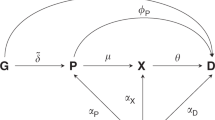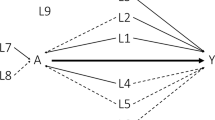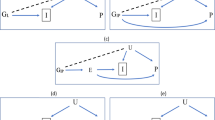Abstract
We propose a multiple estimation adjustment (MEA) method to correct effect overestimation due to selection bias from a hypothesis-generating study (HGS) in pharmacogenetics. MEA uses a hierarchical Bayesian approach to model individual effect estimates from maximal likelihood estimation (MLE) in a region jointly and shrinks them toward the regional effect. Unlike many methods that model a fixed selection scheme, MEA capitalizes on local multiplicity independent of selection. We compared mean square errors (MSEs) in simulated HGSs from naive MLE, MEA and a conditional likelihood adjustment (CLA) method that model threshold selection bias. We observed that MEA effectively reduced MSE from MLE on null effects with or without selection, and had a clear advantage over CLA on extreme MLE estimates from null effects under lenient threshold selection in small samples, which are common among ‘top’ associations from a pharmacogenetics HGS.
This is a preview of subscription content, access via your institution
Access options
Subscribe to this journal
Receive 6 print issues and online access
$259.00 per year
only $43.17 per issue
Buy this article
- Purchase on SpringerLink
- Instant access to full article PDF
Prices may be subject to local taxes which are calculated during checkout





Similar content being viewed by others
References
Dawid AP . Selection paradoxes of bayesian inference. Multivar Anal Appl 1994; 24: 211–220.
Göring HH, Terwilliger JD, Blangero J . Large upward bias in estimation of locus-specific effects from genomewide scans. Am J Hum Genet 2001; 69: 1357–1369.
Ioannidis JP, Ntzani EE, Trikalinos TA, Contopoulos-Ioannidis DG . Replication validity of genetic association studies. Nat Genet 2001; 29: 306–309.
Faye LL, Sun L, Dimitromanolakis A, Bull SB . A flexible genome-wide bootstrap method that accounts for ranking and threshold-selection bias in GWAS interpretation and replication study design. Stat Med 2011; 30: 1898–1912.
Allison DB, Fernandez JR, Heo M, Zhu S, Etzel C, Beasley TM et al. Bias in estimates of quantitative-trait-locus effect in genome scans: demonstration of the phenomenon and a method-of-moments procedure for reducing bias. Am J Hum Genet 2002; 70: 575–585.
Zollner S, Pritchard JK . Overcoming the winner’s curse: estimating penetrance parameters from case-control data. Am J Hum Genet 2007; 80: 605–615.
Ghosh A, Zou F, Wright FA . Estimating odds ratios in genome scans: an approximate conditional likelihood approach. Am J Hum Genet 2008; 82: 1064–1074.
Xiao R, Boehnke M . Quantifying and correcting for the winner's curse in genetic association studies. Genet Epidemiol 2009; 33: 453–462.
Sun L, Bull SB . Reduction of selection bias in genomewide studies by resampling. Genet Epidemiol 2005; 28: 352–367.
Yu K, Chatterjee N, Wheeler W, Li Q, Wang S, Rothman N et al. Flexible design for following up positive findings. Am J Hum Genet 2007; 81: 540–551.
Sun L, Dimitromanolakis A, Faye LL, Paterson AD, Waggott D, Bull SB . BR-squared: a practical solution to the winner’s curse in genome-wide scans. Hum Genet 2011; 129: 545–552.
Daly AK . Genome-wide association studies in pharmacogenomics. Nat Rev Genet 2010; 11: 241–246.
Benjamini Y, Hochberg Y . Controlling the false discovery rate: a practical and powerful approach to multiple testing. J R Stat Soc Ser B 1995; 57: 289–300.
Higdon R, van Belle G, Kolker E . A note on the false discovery rate and inconsistent comparisons between experiments. Bioinformatics 2008; 24: 1225–1228.
Chen GK, Witte JS . Enriching the analysis of genomewide association studies with hierarchical modeling. Am J Hum Genet 2007; 81: 397–404.
Lewinger JP, Conti ÃDV, Baurley JW, Triche TJ, Thomas DC . Hierarchical Bayes prioritization of marker associations from a genome-wide association scan for further investigation. Genet Epidemiol 2007; 882: 871–882.
Thompson JR, Gögele M, Weichenberger CX, Modenese M, Attia J, Barrett JH et al. SNP prioritization using a Bayesian probability of association. Genet Epidemiol 2013; 37: 214–221.
Stein C . Inadmissibility of the usual estimator for the mean of a multivariate normal distribution. Proc Third Berkeley Symp Math Stat Probab 1955; 1: 197–206.
Efron B . Correlation and large-scale simultaneous significance testing. J Am Stat Assoc 2007; 102: 93–103.
Friguet C, Kloareg M, Causeur D . A factor model approach to multiple testing under dependence. J Am Stat Assoc 2009; 104: 1406–1415.
Lunn D, Spiegelhalter D, Thomas A, Best N . The BUGS project: Evolution, critique and future directions. Stat Med 2009; 28: 3049–3067.
The 1000 Genomes Project Consortium, Abecasis GR, Auton A, Brooks LD, DePristo MA, Durbin RM, Handsaker RE et al. An integrated map of genetic variation from 1,092 human genomes. Nature 2012; 491: 56–65.
Park J-H, Wacholder S, Gail MH, Peters U, Jacobs KB, Chanock SJ et al. Estimation of effect size distribution from genome-wide association studies and implications for future discoveries. Nat Genet 2010; 42: 570–575.
Conti DV, Witte JS . Hierarchical modeling of linkage disequilibrium: genetic structure and spatial relations. Am J Hum Genet 2003; 72: 351–363.
Abecasis GR, Noguchi E, Heinzmann A, Traherne JA, Bhattacharyya S, Leaves NI et al. Extent and distribution of linkage disequilibrium in three genomic regions. Am J Hum Genet 2001; 68: 191–197.
Thomas DC, Siemiatycki J, Dewar R, Robins J, Goldberg M, Armstrong BG . The problem of multiple inference in studies designed to generate hypotheses. Am J Epidemiol 1985; 122: 1080–1095.
Efron B . Tweedie’s formula and selection bias. J Am Stat Assoc 2011; 106: 1602–1614.
Chuang-stein C . Sample size and the probability of a successful trial. Pharm Stat 2006; 5: 305–309.
Acknowledgements
We thank Bonnie Fijal for helpful discussions and comments and anonymous reviewers for their comments.
Author information
Authors and Affiliations
Corresponding author
Ethics declarations
Competing interests
WZ completed most of the work as an employee of InVentiv Health Clinical, LLC and HO is an employee of Eli Lilly and Company.
Additional information
Supplementary Information accompanies the paper on the The Pharmacogenomics Journal website
Supplementary information
Rights and permissions
About this article
Cite this article
Zou, W., Ouyang, H. Using local multiplicity to improve effect estimation from a hypothesis-generating pharmacogenetics study. Pharmacogenomics J 16, 107–112 (2016). https://doi.org/10.1038/tpj.2015.19
Received:
Revised:
Accepted:
Published:
Issue Date:
DOI: https://doi.org/10.1038/tpj.2015.19



